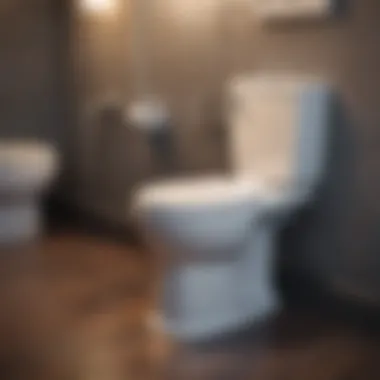Understanding Slow Flushing Toilet Clogs: Causes and Solutions


Intro
Slow flushing toilets are a common issue faced by many homeowners. This problem can cause significant inconvenience and frustration, leading to multiple trips to the bathroom without the desired results. Understanding the factors that contribute to this issue is essential for effective resolution and maintenance.
In this article, we will explore the underlying causes of slow flushing toilets. Factors like clogs, inadequate water pressure, and faulty mechanisms will be examined in detail. We will also discuss practical solutions that homeowners can implement themselves, as well as when to call a professional.
Moreover, we’ll address common misconceptions regarding toilet performance and maintenance. Property owners often overlook simple steps that can prevent slow flushing issues from arising. Through this comprehensive guide, we aim to equip readers with the necessary knowledge to address any toilet-related concerns effectively, ensuring the seamless operation of their plumbing systems.
Intro to Slow Flushing Toilets
Understanding slow flushing toilets is crucial for maintaining a functional and efficient plumbing system in any home. These toilets often represent a significant inconvenience for homeowners, leading not only to dissatisfaction but also potentially escalating plumbing issues. A slow flush can indicate underlying problems that, if not addressed, may result in more extensive repairs and higher costs.
Toilets are an integral part of household plumbing, and their efficiency impacts daily life in numerous ways. Observing their performance can provide insights into the health of the entire plumbing system. Homeowners should understand that slow flushing is not merely a nuisance; it can signify a variety of issues ranging from simple clogs to more complex mechanical failures.
When we discuss slow flushing toilets, we focus on several aspects: the causes, the signs indicating a problem, and potential solutions. Recognizing these elements equips homeowners with the knowledge to take proactive steps. With careful attention, one can preserve the longevity of their toilet, while also ensuring proper operation and minimizing repairs.
In this segment, we will unpack the importance of this issue and set the stage for deeper discussions regarding the functionality of toilets, the mechanics driving them, and the common problems faced. This awareness not only helps in diagnosing situations but also empowers homeowners to engage effectively with plumbing professionals when needed.
Ultimately, this article serves to educate about slow flushing toilets, emphasizing the need for regular maintenance and an understanding of potential issues. Adopting a well-informed approach can enhance toilet performance and maintain plumbing integrity over time.
Understanding the Mechanism of Toilets
To comprehend the intricacies of slow flushing toilets, it is essential to understand the mechanism of toilets. This knowledge offers insight into how your toilet operates, allowing for better troubleshooting and maintenance. A well-functioning toilet is a critical component of a household's plumbing system. By knowing how toilets work, homeowners can identify issues sooner and potentially fix problems before they become major headaches.
Components of a Toilet System
The toilet system consists of several key components, each playing a significant role in its operation. Understanding these components is vital for diagnosing issues:
- Bowl: This is the part where waste collects. It holds water and facilitates the flushing process.
- Tank: Located above the bowl, the tank stores water used for flushing. It is equipped with mechanisms to control water levels.
- Flush Valve: This valve opens when the toilet is flushed, allowing water from the tank to enter the bowl.
- Flapper Valve: This rubber part sits at the bottom of the tank and seals the flush valve. It controls the flow of water from the tank to the bowl during a flush.
- Fill Valve: Responsible for refilling the tank after a flush, the fill valve regulates water flow.
- Overflow Tube: This prevents overflow by directing excess water back into the bowl.
Understanding these components helps homeowners recognize what might be malfunctioning when their toilet is slow to flush.
How Toilets Flush
The flushing process is a combination of gravity and water flow. Here's how it works step-by-step:
- Initiation: When the flush handle is pressed, the flapper valve opens, releasing water from the tank into the bowl.
- Water Flow: As water rushes into the bowl, it carries waste away through the trap and into the drainage system.
- Pressure and Siphon Effect: The rush of water creates a siphon effect that helps pull waste through the plumbing.
- Refilling: After the flush, the flapper valve closes, stopping the flow of water. The fill valve activates, refilling the tank to prepare for the next flush.
Understanding how this process works is crucial for determining if an issue lies with the flushing mechanism. If any component fails to perform its intended function, it could lead to inefficient flushing and possible clogs.
Common Causes of Slow Flushing Toilets
Understanding the common causes of slow flushing toilets is crucial for both homeowners and property managers. It not only allows for timely interventions but also saves money and prevents further plumbing issues. Identifying the root causes early on can keep the toilet functioning effectively, ensuring that the household routine remains uninterrupted. By focusing on these causes, one can also apply preventative measures to maintain optimal toilet operation.
Clogs in the Toilet Trap


Clogs in the toilet trap represent one of the more prevalent reasons a toilet might flush slowly. The trap, a curved section of the drain pipe, is designed to hold water and prevents sewer gases from entering the home. Over time, foreign objects, excessive toilet paper, or waste can build up in this area, leading to a blockage. This blockage restricts the flow of water and waste through the system. To address this issue, one can carefully use a plunger or a plumbing snake to remove the obstruction. Regular checks can help in preventing major clogs from forming.
Problems with the Flapper Valve
The flapper valve is another critical component influencing a toilet's flush performance. This part sits at the bottom of the tank and controls the release of water into the bowl during a flush. If the flapper does not create a proper seal, water may leak into the bowl, resulting in slow flushing and inefficient water use. Signs of flapper issues include running water or difficulty in flushing. Examination of the flapper for wear or distortion is advisable, and replacing it is often a straightforward fix that can restore the toilet's effectiveness.
Issues with the Fill Valve
The fill valve manages the incoming water supply to the toilet tank. If the fill valve is defective, it may not allow enough water into the tank, leading to insufficient flushing power. The result is often a toilet that struggles to clear its contents completely. To determine if the fill valve is functioning properly, one can flush the toilet and observe how quickly the tank refills. If the process is slow, a replacement of the fill valve may be necessary. Regular monitoring of this component can enhance efficiency in toilet operation.
Low Water Levels in the Tank
Low water levels in the toilet tank can significantly impact flushing performance. A tank that is not filled to the correct level does not provide an adequate water supply for a powerful flush. Factors that may affect water levels include improper float adjustment or a malfunctioning fill valve. Homeowners can troubleshoot this by adjusting the float arm or examining the fill valve to ensure efficient water flow. Maintaining the correct water level can make a notable difference in toilet function and effectiveness.
Identifying Signs of a Clogged Toilet
Identifying signs of a clogged toilet is crucial for maintaining the efficiency of your plumbing system. A sluggish toilet can lead to more serious issues if not addressed promptly. Understanding these signs helps you to recognize trouble before it escalates, thus avoiding costly repairs and ensuring a smooth operation of your bathroom facilities.
Frequent Need for Flushing
One of the most telling signs of a clogged toilet is the frequent need for flushing. If you find yourself having to flush multiple times for waste to disappear, this indicates an underlying issue. Ideally, a toilet should empty its contents with a single flush. However, if waste remains after flushing, it may suggest a partial blockage in the toilet trap, drain line, or even issues with the flapper valve.
This excessive requirement to flush can be irritating and wasteful. It may also hint at larger plumbing troubles. If not resolved quickly, these problems could worsen, leading to more complex and expensive plumbing repairs in the future.
Water Backup in the Bowl
Another critical sign of a clogged toilet is water backup in the bowl. If water rises to the rim or overflows when you flush, something is certainly amiss. This can occur due to blockages somewhere in the plumbing system, such as accumulated waste or foreign objects obstructing the pipes.
Additionally, water backup can indicate that the sewer line is experiencing issues, especially if backups occur in multiple fixtures in the home. Monitoring any signs of backup is important, as neglect can result in plumbing emergencies.
"Addressing these symptoms early can prevent plumbing catastrophes and ensure hygiene and convenience in your home."
Recognizing these signs are vital for maintaining a functioning toilet. Taking action when faced with these symptoms can save time, money, and stress related to major plumbing issues.
Step-by-Step Solutions for Slow Flushing Toilets
Slow flushing toilets can be a source of frustration for homeowners. Understanding solutions is essential in maintaining a functioning plumbing system. Addressing these issues not only improves toilet performance but also prevents further plumbing complications. The following sections outline specific methods to resolve slow flushing. Each approach has its own benefits and considerations to keep in mind.
Clearing Obstructions Using a Plunger
Using a plunger is often the first line of defense in addressing slow flushing. It works by creating pressure that can dislodge blockages in the toilet trap. When using a plunger, ensure that you have a good seal around the toilet drain. Push down firmly but gently to avoid damaging the toilet. If you notice resistance, maintain steady pressure and pull back slightly before pushing down again. This technique is effective for minor clogs and can be done quickly.
Using a Toilet Auger
If the plunger does not resolve the issue, a toilet auger may be necessary. This tool is designed for more stubborn clogs located deeper in the toilet drain. Insert the auger into the toilet bowl and turn the handle to send the cable deeper into the drain. With proper use, the auger can break apart or pull out the obstruction. Beyond just clearing, using a toilet auger can provide insights about the blockage's nature, which is helpful for prevention in the future.
Inspecting and Replacing the Flapper and Fill Valves


Flapper and fill valves play crucial roles in ensuring proper flushing mechanism. If these components are malfunctioning, they can lead to reduced flushing effectiveness. Inspect the flapper for mineral buildup or wear. If the flapper appears damaged, replacing it is a straightforward solution that can restore flushing power. The fill valve should also be checked; if it fails to shut off properly, it may cause the toilet to lose water, resulting in a poor flush. This inspection and possible replacement can have long-term benefits for toilet efficiency.
Adjusting Water Levels in the Tank
Water levels in the tank are critical for adequate flushing. If the water level is too low, it will not generate sufficient force for a proper flush. Adjust the float mechanism within the tank to increase the water level. This adjustment can be made by modifying the height of the float or adjusting the fill valve. Regular checks of the tank's water levels help ensure consistent flushing performance and can prevent related issues down the line.
Preventative Maintenance for Toilets
Preventative maintenance for toilets is essential in ensuring their long-term functionality and efficiency. Many homeowners often overlook the simple tasks that can prevent more complex issues like slow flushing or clogs. By adopting regular maintenance routines, one can significantly reduce the likelihood of encountering problems in the future. This practice helps to sustain optimal performance, ultimately saving both time and money.
Regular Cleaning Routines
Regular cleaning routines are key to maintaining a toilet's efficiency. Over time, buildup of minerals and bacteria can affect the performance of toilets. Utilizing a toilet bowl cleaner that targets limescale and stains can be beneficial. Applying it regularly can prevent corrosion and ensure that the flush remains powerful and uninterrupted.
Additionally, it is advisable to clean under the rim of the bowl where dirt and sediment may accumulate. Using a toilet brush can help dislodge any material that may obstruct water flow during flushing. Establishing a cleaning schedule, perhaps once a week, can help keep the toilet fresh and functional.
Avoiding Non-Flushable Items
Another crucial aspect of preventative maintenance is awareness of what can and cannot be flushed. Many items labeled as "flushable" can actually lead to clogs over time. Products such as paper towels, wipes, and feminine hygiene products should always be disposed of in the trash, not the toilet.
Creating a household rule regarding flushing habits can minimize the risk of slow flushing and clogs. Educating all household members about proper disposal methods is an effective way to maintain toilet health and avoid unnecessary plumbing issues.
Periodic Professional Inspections
Periodic professional inspections are also very useful in toilet maintenance. Even if a toilet appears to function well, an experienced plumber can identify and address potential problems before they escalate. Regular checks should ideally occur every couple of years, or sooner if any symptoms of trouble appear.
During inspections, professionals can evaluate components such as the flapper, fill valve, and overall water efficiency. This proactive approach helps catch wear and tear before it leads to failures or costly repairs, ensuring that the toilet remains a dependable element of the home plumbing system.
Keeping a toilet in optimal working condition requires minimal effort and attention. Regular cleaning, proper disposal practices, and professional inspections are simple yet effective ways to prevent issues.
By investing time into these aspects of preventative maintenance, homeowners can enjoy a hassle-free toilet experience for years to come.
Misconceptions about Toilet Functionality
Understanding misconceptions about toilet functionality is crucial for homeowners. Many people operate under false beliefs that lead to inefficient use of their toilets. Myth identification can assist in making informed decisions about toilet maintenance and upgrades. When misconceptions are addressed, it can improve toilet efficiency and reduce clogs, ultimately saving on repair costs and ensuring better plumbing functionality.
The Myth of High-Pressure Flush
One common belief is that a high-pressure flush is necessary for effective waste removal. This myth persists due to the association of pressure with performance. However, modern toilets are engineered to be efficient without relying on excessive pressure. These toilets use gravity and precise engineering to facilitate waste removal effectively.
High-pressure systems may seem more powerful, but they can actually lead to plumbing issues over time. Excessive pressure can cause pipes to wear out faster and increase the risk of leaks. Homeowners can benefit by choosing models designed with low-flow technology. These toilets utilize less water per flush while still maintaining effectiveness.
"Efficient toilets do not rob your plumbing; rather, they harmonize with it."
When considering a toilet, prioritize technology that combines efficiency with performance. Look for toilets labeled as WaterSense. These models not only perform well but also meet standards set by the Environmental Protection Agency. This helps in ensuring that you contribute to water conservation efforts while not sacrificing functionality.


Understanding Toilet Design Variations
Toilet design variations are often misunderstood. Some may believe that all toilets function the same way, leading to confusion when one model does not perform as expected. Important differences exist between various classes, including gravity-fed and pressure-assist toilets. These variations can affect both performance and the frequency of clogs.
- Gravity-Fed Toilets: These rely primarily on gravity for the flush. They operate with a straightforward design, making them widely used in homes.
- Pressure-Assist Toilets: These models use a sealed tank system. They add pressure to the water during a flush, which can result in a stronger flush.
Each design has its own set of benefits and drawbacks. Understanding your choice can inform maintenance habits. For instance, pressure-assist toilets may require more frequent checks for proper pressure levels, while gravity-fed models might need regular cleaning to avoid clogging in the trap. Understanding these distinctions can empower homeowners to select and maintain their toilets more effectively.
By demystifying toilet functionality and addressing these misconceptions, readers can improve their knowledge, make better choices regarding toilet purchase and upkeep, resulting in a more efficient and functional plumbing system.
The Importance of Proper Toilet Selection
Selecting the right toilet is a crucial aspect of maintaining a functional and efficient plumbing system. The toilet is a central fixture in any bathroom, and its performance can significantly impact overall household efficiency. Choosing an appropriate model contributes not only to proper flushing and reduced clogs but also enhances water efficiency and design aesthetic.
A well-selected toilet can mitigate the issues of slow flushing clogs. When homeowners opt for toilets designed with superior flushing technology, the likelihood of clogs decreases. Additionally, an appropriate toilet model is essential for ensuring that water pressure and flow are optimized, further maintaining the system’s integrity. This, in turn, can prevent the need for frequent repairs.
Choosing the Right Model
When it comes to choosing the right toilet model, several factors should be prioritized. Homeowners should consider the size of their bathroom space, the style of the toilet, and the flush mechanism. Here are some key points to consider:
- Size and Space: Compact toilets are ideal for small bathrooms. They save space while still providing functionality.
- Flush Mechanisms: Models with dual-flush capabilities provide flexibility for regular versus heavy usage. It helps users conserve water.
- Design Preferences: The visual appeal of the toilet can enhance the overall aesthetic of a bathroom.
- Brand Reputation: Renowned brands often have better technology and customer support.
To illustrate,
"Investing in a quality toilet model can lead to long-term savings by reducing water usage and minimizing plumbing issues."
Considerations for Water Efficiency
Water efficiency is an important consideration in toilet selection. Modern toilets are designed with various technologies to minimize water usage without compromising performance. Here are some considerations:
- Water-Saving Technologies: Many toilets today utilize 1.6 gallons per flush or less. In comparison, older models typically use 3.5 to 5 gallons.
- Eco-Friendly Options: Look for models certified by the Environmental Protection Agency under the WaterSense program. These toilets are designed to perform well while saving water.
- Gravity-Flush vs. Pressure-Assisted: Pressure-assisted toilets use air pressure to enhance flush efficiency and are often more effective at moving waste while using less water.
- Regular Maintenance: Maintaining proper water levels in the tank can enhance the flushing performance of any model.
By selecting toilets that promote water efficiency, homeowners contribute to sustainable practices while enhancing the functionality of their bathroom spaces. This decision directly influences the effectiveness of flushing systems and consequently the chances of encountering slow flushing clogs.
In summary, proper toilet selection is pivotal in avoiding plumbing issues and improving water efficiency. Opting for the right model with an eye on the design and functionality promotes the longevity and performance of plumbing systems.
The End: Enhancing Toilet Performance
In any discussion of toilet functionality, the focus on enhancing performance cannot be overstated. Slow flushing toilets are not merely an inconvenience; they can lead to more significant plumbing issues in the future if not addressed properly. A well-functioning toilet is critical for maintaining hygiene and comfort in the home. Therefore, understanding the various factors that contribute to slow flushing is essential for homeowners.
Importance of Effective Solutions
Implementing effective solutions is vital for restoring optimal toilet performance. Homeowners should recognize that issues such as clogs and valve malfunctions often stem from a lack of maintenance or improper use. By following the outlined steps in the article, individuals can effectively address these common problems. Moreover, regular maintenance and appropriate product choices play a crucial role in preventing future issues.
Benefits of Routine Care
Routine care not only enhances toilet performance but also contributes to the longevity of plumbing systems. Simple actions like regular cleaning and professional inspections can help identify potential problems before they escalate. Furthermore, maintaining awareness of what can and cannot be flushed reduces the risk of serious clogs.
Considerations for Future Upgrades
For those contemplating upgrades to their toilet system, it’s important to consider models known for efficiency. The right model can significantly improve performance while also conserving water. Additionally, emphasis on user education around product features can further optimize toilet function.
"A well-maintained toilet is the first line of defense against plumbing disasters."







